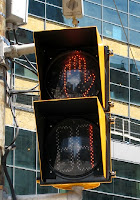
Yesterday we had the opportunity to see a set of research demos at the lab of Antonio Krüger at the
 We saw exciting work in progress – a nearly ready large scale multi-touch display based on frustrated total internal reflection – according to Antonio the world-largest at the moment. The principle of operation of such a display is very appealing and the demo was convincing. For a comprehensive introduction on the topic see Jef Han’s UIST 2005 technote “Low-cost multi-touch sensing through frustrated total internal reflection” http://doi.acm.org/10.1145/1095034.1095054) . I really think we should build one, too (obviously a bit bigger than Antonio’s 😉
We saw exciting work in progress – a nearly ready large scale multi-touch display based on frustrated total internal reflection – according to Antonio the world-largest at the moment. The principle of operation of such a display is very appealing and the demo was convincing. For a comprehensive introduction on the topic see Jef Han’s UIST 2005 technote “Low-cost multi-touch sensing through frustrated total internal reflection” http://doi.acm.org/10.1145/1095034.1095054) . I really think we should build one, too (obviously a bit bigger than Antonio’s 😉







